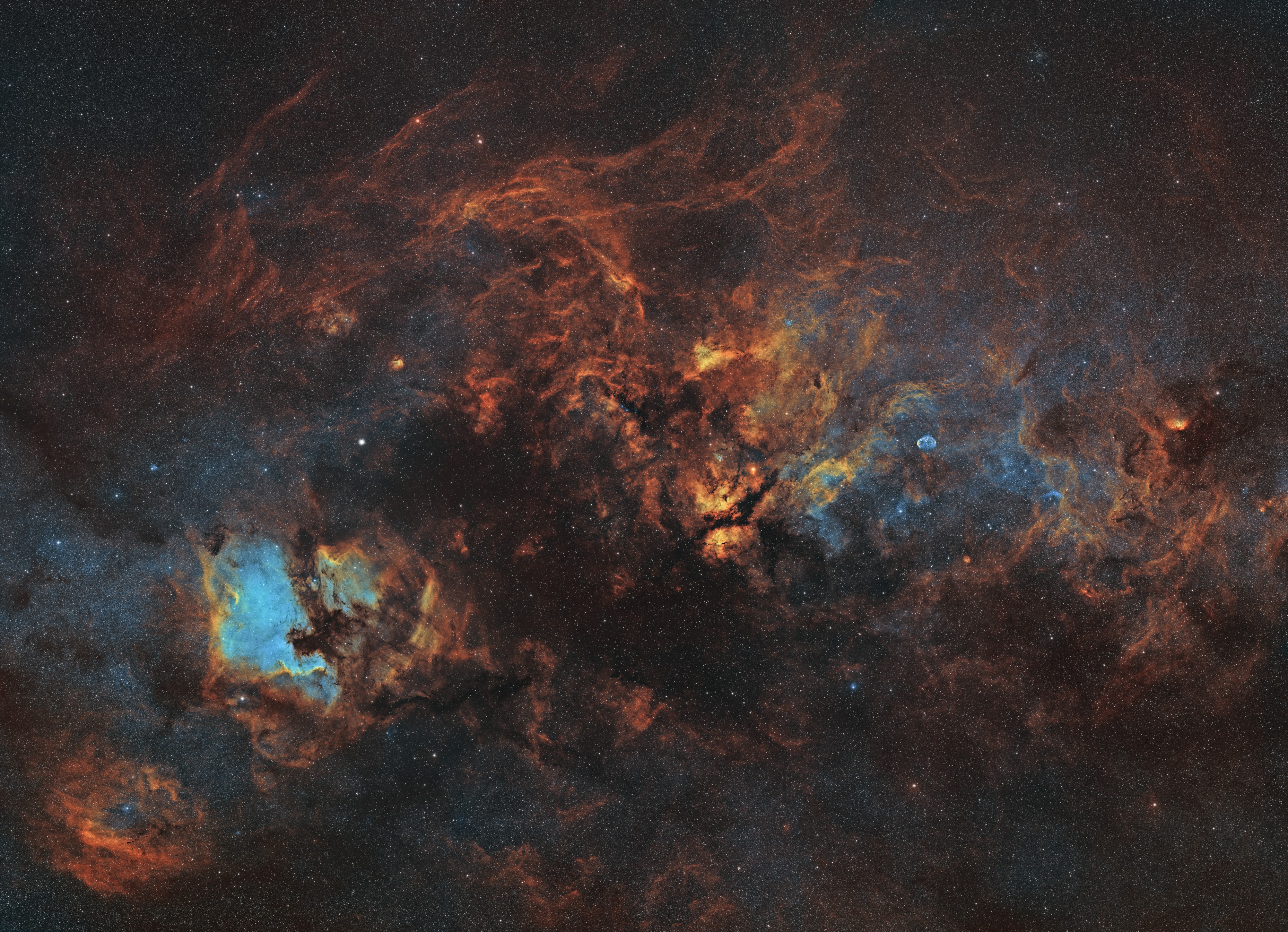The Flames of Cygnus – a 9 panels mosaic. Interactive version here.
My biggest project so far! It took me 2 months – a total of roughly 60 hours of exposure time, 20 hours of processing time and 30 hours of computation time – to make this 104 megapixels image.
Here’s an illustration showing how big this region appears in the sky compared to the moon (bottom right).
Equipment
- Samyang 135mm f/2
- QHY163M
- Baader narrowband filters
- Sky-Watcher HEQ5 Pro
- QHY5L-II-C and QHY 30mm guidescope
Acquisition (Total : 58.8h)
- Location : Backyard, bortle 5
- Ha : 643x180s (32.1h)
- OIII : 534x180s (26.7h)
- Calibration : darks, flats
Processing (PixInsight)
Individual channel processing
- Background levels equalization (dnaLinearFit)
- GradientMergeMosaic
- Gradient removal (DBE and ABE)
- Deconvolution (tutorial)
- Noise reduction (TGV and MMT)
- HistogramTransformation
Color combination (tutorial)
- StarNet++ on Ha and Oiii
- Creating the dynamic factors
- f1 : Oiii
- Boosted using curves
- f2 : Oiii
- Boosted++ using curves
- f1 : Oiii
- Creating a weaker version of Ha
- Ha_weak : Ha
- Flattened using HDRMMT and curves
- Ha_weak : Ha
- Combining the channels with PixelMath
- R : f1*Ha_weak + ~f1*Ha
- G : f2*Ha + ~f2*Oiii
- B : Oiii
Luminance processing
- Creating the dynamic factor
- f : Oiii*~Ha
- Boosted using curves, noise reduced using MMT
- f : Oiii*~Ha
- Creating the synthetic luminance with PixelMath
- L : f*Oiii + ~f*Ha
- StarNet++
-
Sharpening (MMT)
-
HDRMultiscaleTransform
-
LocalHistogramEqualization
-
Adding the stars back (PixelMath)
- Star reduction (tutorial)
LRGB processing
- LRGBCombination
- CurvesTransformation
- SCNR
Taken in July – September 2020

This is a totally insane and breathtaking image. Astrophotography at its finest. Big, big compliments and congratulations from the Netherlands 😉
Daniel
Thank you Daniel 😀
C’est excellent! Félicitations.
Merci !
Exquisite. Probably one of the best Astrophotograph i have ever seen. You should sell it. Would make a great portrait.
Thank you very much! I’ll let you know if I do 😄
It’s really impressive ! Good job !
Thank you!
When you say something is « Boosted using curves » what exactly are you doing in CurvesTransformation? Also, if I’m following this correctly, the only place the stars come back in is on the L layer, yet the stars in the final image have color. How did you accomplish that?
“Boosted using curves” simply means that I’m applying a standard S curve. I recommend you to read my tutorial on narrowband combinations for more information!
You read it correctly – the stars color should be of the same hue as the starless background color. The only stars that aren’t white are those that are on “top” of nebulosity.
It’s a very inspiring masterpiece! Congratulations for this excellent result !!!
Thank you!
Congratulations! Impressive image.
Have you tried a starless version of this one?
I usually prefer with stars but on this image removing stars could help to highlight the nebulosity even more.
Thanks ! I have but I never posted it online. Here it is : https://thecoldestnights.com/wp-content/uploads/2020/11/CygnusMosaic_small_starless.jpg
Awesome! It gained a lot of depth, almost 3D in the upper part.
Breathtaking! Really love this beautiful picture – especially how it shows the nebulousity in North America and how the dark clouds are between us and the nebula.
Clear skies!
Thank you so much!
Superb composition on all of your astrophotography images! If you don’t mind me asking, what aperture(s) do you use on the Samyang 135f/2 lens. The reason I ask is if one wants to take full advantage of a fast lens then high speed filters benefit. Do you use high speed filters or normal filters(non-high speed) and stop the lens down to ie. f/3.5-4 or another aperture?
Thank you for sharing.
Hi,
Thank you for your comment!
I use relatively wide narrowband filters (the Baader ones, which are all around 7nm wide). The signal loss caused by bandpass shift is not as bad as it would be with narrower filters, so there is no real need to stop down. From my experiences, f/2 and f/2.8 yielded similar results and both were better than f/3.5 and slower, so I always go for f/2 by default. Though, theoretically, those results could vary depending on the amount of light pollution (the more light pollution, the more you should stop down). Anyway, high-speed filters would perform better, I just don’t own a set !
Thank you for your prompt reply.
Your astrophotography images, answer and explanation has made it clear to me that I won’t part ways with my Samyang/Rokinon F/2 lens for the WO Red Cat 51. I may in the future opt for narrowband filters instead.
The value of fast optics along with the performance at F/2 of this lens bring many benefits to astrophotography.
Thank you again for sharing your experience!